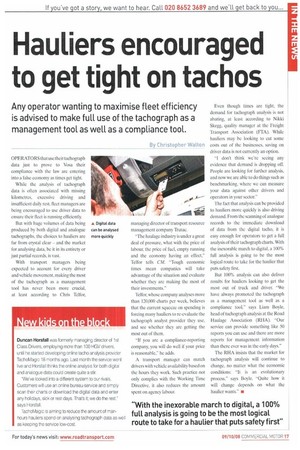Hauliers encouraged to get tight on tachos
Page 17

If you've noticed an error in this article please click here to report it so we can fix it.
Any operator wanting to maximise fleet efficiency is advised to make full. use of the tachograph as a management tool. as well, as a compliance tool.
By Christopher Walton
OPERATORS that use their tachograph data just to prove to Vosa their compliance with the law are entering into a false economy as times get tight.
While the analysis of tachograph data is often associated with missing kilometres, excessive driving and insufficient daily rest, fleet managers are being encouraged to use driver data to ensure their fleet is running efficiently.
But with huge volumes of data being produced by both digital and analogue tachographs, the choices to hauliers are far from crystal clear — and the market for analysing data, be it in its entirety or just partial records, is vast.
With transport managers being expected to account for every driver and vehicle movement, making the most of the tachograph as a management tool has never been more crucial, at least according to Chris Telfor, managing director of transport resource management company Trutac.
"The haulage industry is under a great deal of pressure, what with the price of labour, the price of fuel, empty running and the economy having an effect," Telfor tells CM. "Tough economic times mean companies will take advantage of the situation and evaluate whether they are making the most of their investments."
Telfor, whose company analyses more than 120,000 charts per week, believes that the current squeeze on spending is forcing many hauliers to re-evaluate the tachograph analyst provider they use, and see whether they are getting the most out of them.
"If you are a compliance-reporting company, you will do well if your price is reasonable," he adds.
A transport manager can match drivers with vehicle availability based on the hours they work. Such practice not only complies with the Working Time Directive, it also reduces the amount spent on agency labour. Even though times are tight, the demand for tachograph analysis is not abating, at least according to Nikki Skegg, quality manager at the Freight Transport Association (PTA). While hauliers may be looking to cut some costs out of the businesses, saving on driver data is not currently an option.
"1 don't think we're seeing any evidence that demand is dropping off. People are looking for further analysis, and now we are able to do things such as benchmarking, where we can measure your data against other drivers and operators in your sector."
The fact that analysis can be provided to hauliers more quickly is also driving demand. From the scanning of analogue records to the immediate download of data from the digital tacho, it is easy enough for operators to get a full analysis of their tachograph charts. With the inexorable march to digital, a 100% full analysis is going to be the most logical route to take for the haulier that puts safety first.
But 100% analysis can also deliver results for hauliers looking to get the most out of truck and driver. "We have always promoted the tachograph as a management tool as well as a compliance tool," says Liam Boyle, head of tachograph analysis at the Road Haulage Association (RHA). "Our service can provide something like 50 reports you can use and there are more reports for management information than there ever was in the early days."
The RHA insists that the market for tachograph analysis will continue to change, no matter what the economic conditions: "It is an evolutionary process," says Boyle. "Quite how it will change depends on what the haulier wants." •








































































































































































